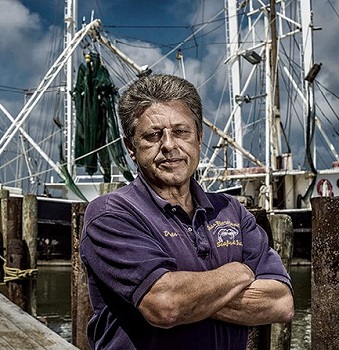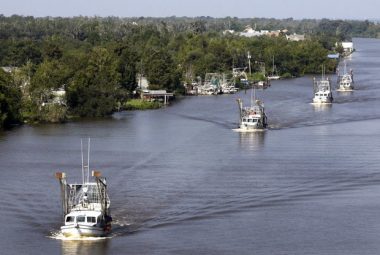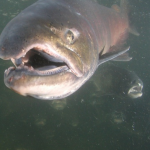Tag Archives: Gulf of Mexico Dead zone

The Dead Zone – Nothing Here Gets Out Alive
With an easy drawl, Dean Blanchard, the owner of Dean Blanchard Seafood in the barrier-island town of Grand Isle, Louisiana, makes an understated observation: “There’s a reason they call it a dead zone. When the dead zone comes, everything’s dead. We can’t catch dead stuff. We’re in the live stuff business.” What Blanchard is talking about is the Gulf of Mexico “dead zone,” an enormous area in which, every spring, an overgrowth of algae and other vegetation absorbs dissolved oxygen from the water and kills all animal life. “This year,” Blanchard says, “we had shrimp jumping on the beach, committing suicide, trying to get out of the water because there’s no oxygen.” The result is an economic disaster. To find live shrimp, fishers have to ply their boats as far as fifty miles from shore. “With the price of fuel, you don’t want to go too far,” Blanchard says. His company’s annual haul has declined from twelve million pounds of shrimp a year to under five million. He used to employ sixty workers—now he’s down to thirty. >click to read< 11:49

Louisiana Fisherman Talks Water Quality and Nutrient Reduction with Iowa Farmers
Nutrient runoff from Iowa agriculture is one of the leading causes of the growing “dead zone” in the Gulf of Mexico, an oxygen-deprived section of the Gulf, which last year was recorded to be the size of the state of New Jersey. “About 29 percent of the load coming into the Gulf originates in Iowa,” says Larry Weber, an executive associate dean professor in the University of Iowa’s College of Engineering. “If we take the Iowa portion out of the Gulf, then the nitrate load to the Gulf of Mexico would be going down. The real challenge in fixing the Gulf hypoxia starts in Iowa.” In this special edition of River to River, host Clay Masters talks with panelists about what Iowa farmers are doing, or not doing, when it comes to reducing nutrient runoff into the Mississippi River. He also speaks with Thomas Olander, Chairman of the Louisiana Shrimp Association and a fourth generation shrimper. Audio report >click to listen<10:23
Price spikes for jumbo shrimp blamed on Gulf of Mexico dead zone
 Every spring and summer when the low-oxygen dead zone forms off Louisiana’s coastline, the price of jumbo shrimp briefly spikes, affecting Gulf of Mexico fishers, consumers and seafood markets, according to a new study published Monday (Jan. 30) in the Proceedings of the National Academy of Sciences. And the price for smaller shrimp generally falls. The positive effect of the price increase on jumbo shrimp for Gulf commercial shrimpers are fleeting, however. That’s because the rise often triggers increased imports of large shrimp from foreign producers, including farm-raised shrimp, which quickly drive down prices. The dead zone is an area of low oxygen — with levels of oxygen at or below 2 parts per million — that scientists define as hypoxia. Freshwater rich in nitrogen and phosphorus from Midwest farms and from nutrient-rich sewage from cities and rural areas enters the Gulf each spring and summer, forming a freshwater layer over the Gulf’s saltier sea water. Read the full story here 18:41
Every spring and summer when the low-oxygen dead zone forms off Louisiana’s coastline, the price of jumbo shrimp briefly spikes, affecting Gulf of Mexico fishers, consumers and seafood markets, according to a new study published Monday (Jan. 30) in the Proceedings of the National Academy of Sciences. And the price for smaller shrimp generally falls. The positive effect of the price increase on jumbo shrimp for Gulf commercial shrimpers are fleeting, however. That’s because the rise often triggers increased imports of large shrimp from foreign producers, including farm-raised shrimp, which quickly drive down prices. The dead zone is an area of low oxygen — with levels of oxygen at or below 2 parts per million — that scientists define as hypoxia. Freshwater rich in nitrogen and phosphorus from Midwest farms and from nutrient-rich sewage from cities and rural areas enters the Gulf each spring and summer, forming a freshwater layer over the Gulf’s saltier sea water. Read the full story here 18:41
Our Views: Gulf of Mexico Dead zone needs attention

Louisiana — and the nation that depends upon its fisheries — can’t afford anything less. continued@ theadvocate














































